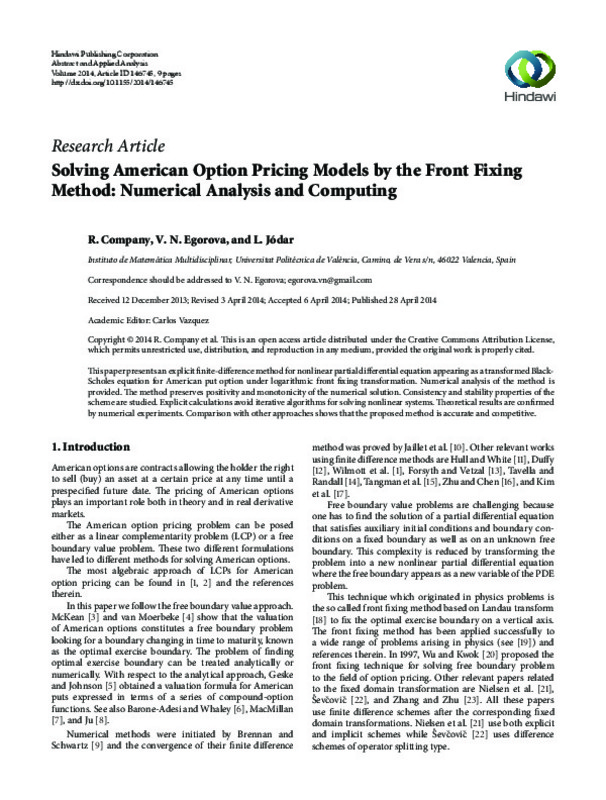Feng, L., Linetsky, V., Luis Morales, J., & Nocedal, J. (2011). On the solution of complementarity problems arising in American options pricing. Optimization Methods and Software, 26(4-5), 813-825. doi:10.1080/10556788.2010.514341
Van Moerbeke, P. (1976). On optimal stopping and free boundary problems. Archive for Rational Mechanics and Analysis, 60(2), 101-148. doi:10.1007/bf00250676
GESKE, R., & JOHNSON, H. E. (1984). The American Put Option Valued Analytically. The Journal of Finance, 39(5), 1511-1524. doi:10.1111/j.1540-6261.1984.tb04921.x
[+]
Feng, L., Linetsky, V., Luis Morales, J., & Nocedal, J. (2011). On the solution of complementarity problems arising in American options pricing. Optimization Methods and Software, 26(4-5), 813-825. doi:10.1080/10556788.2010.514341
Van Moerbeke, P. (1976). On optimal stopping and free boundary problems. Archive for Rational Mechanics and Analysis, 60(2), 101-148. doi:10.1007/bf00250676
GESKE, R., & JOHNSON, H. E. (1984). The American Put Option Valued Analytically. The Journal of Finance, 39(5), 1511-1524. doi:10.1111/j.1540-6261.1984.tb04921.x
BARONE-ADESI, G., & WHALEY, R. E. (1987). Efficient Analytic Approximation of American Option Values. The Journal of Finance, 42(2), 301-320. doi:10.1111/j.1540-6261.1987.tb02569.x
Ju, N. (1998). Pricing by American Option by Approximating its Early Exercise Boundary as a Multipiece Exponential Function. Review of Financial Studies, 11(3), 627-646. doi:10.1093/rfs/11.3.627
Jaillet, P., Lamberton, D., & Lapeyre, B. (1990). Variational inequalities and the pricing of American options. Acta Applicandae Mathematicae, 21(3), 263-289. doi:10.1007/bf00047211
Hull, J., & White, A. (1990). Valuing Derivative Securities Using the Explicit Finite Difference Method. The Journal of Financial and Quantitative Analysis, 25(1), 87. doi:10.2307/2330889
Forsyth, P. A., & Vetzal, K. R. (2002). Quadratic Convergence for Valuing American Options Using a Penalty Method. SIAM Journal on Scientific Computing, 23(6), 2095-2122. doi:10.1137/s1064827500382324
Tangman, D. Y., Gopaul, A., & Bhuruth, M. (2008). A fast high-order finite difference algorithm for pricing American options. Journal of Computational and Applied Mathematics, 222(1), 17-29. doi:10.1016/j.cam.2007.10.044
Zhu, S.-P., & Chen, W.-T. (2011). A predictor–corrector scheme based on the ADI method for pricing American puts with stochastic volatility. Computers & Mathematics with Applications, 62(1), 1-26. doi:10.1016/j.camwa.2011.03.101
Landau, H. G. (1950). Heat conduction in a melting solid. Quarterly of Applied Mathematics, 8(1), 81-94. doi:10.1090/qam/33441
Kim, I. J. (1990). The Analytic Valuation of American Options. Review of Financial Studies, 3(4), 547-572. doi:10.1093/rfs/3.4.547
Kangro, R., & Nicolaides, R. (2000). Far Field Boundary Conditions for Black--Scholes Equations. SIAM Journal on Numerical Analysis, 38(4), 1357-1368. doi:10.1137/s0036142999355921
Company, R., Jódar, L., & Pintos, J.-R. (2012). A consistent stable numerical scheme for a nonlinear option pricing model in illiquid markets. Mathematics and Computers in Simulation, 82(10), 1972-1985. doi:10.1016/j.matcom.2010.04.026
Panini, R., & Srivastav, R. P. (2004). Option pricing with Mellin transnforms. Mathematical and Computer Modelling, 40(1-2), 43-56. doi:10.1016/j.mcm.2004.07.008
Kuske, R. A., & Keller, J. B. (1998). Optimal exercise boundary for an American put option. Applied Mathematical Finance, 5(2), 107-116. doi:10.1080/135048698334673
Ikonen, S., & Toivanen, J. (2004). Operator splitting methods for American option pricing. Applied Mathematics Letters, 17(7), 809-814. doi:10.1016/j.aml.2004.06.010
Han, H., & Wu, X. (2003). A Fast Numerical Method for the Black--Scholes Equation of American Options. SIAM Journal on Numerical Analysis, 41(6), 2081-2095. doi:10.1137/s0036142901390238
[-]









